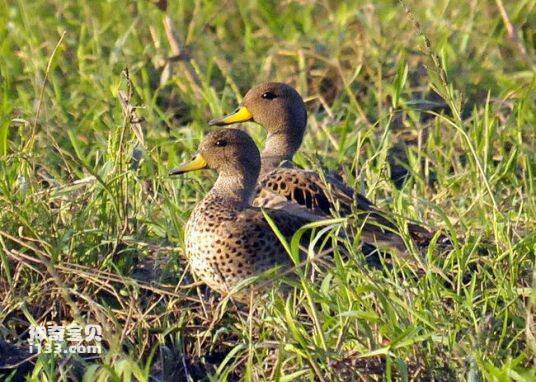Anas flavirostris
IUCN
LCBasic Information
Scientific classification
- name:Anas flavirostris
- Scientific Name:Anas flavirostris,Speckled Teal
- Outline:Waterfowl
- Family:
Vital signs
- length:No textual research information is available
- Weight:No textual research information is available
- lifetime:No textual research information is available
Feature
It has brown and yellow mottled upper body and wings
Distribution and Habitat
It is found in Argentina, Bolivia, Brazil, Chile, the Malvinas Islands, Paraguay, Peru, South Georgia and the South Sandwich Islands, and Uruguay.
It usually lives in freshwater lakes, but also groups in rivers, lakes, reservoirs, bays and coastal salt flats and other waters.
Appearance
There are four subspecies of the duck, which vary in color depending on where they are distributed. Both have brown and yellow mottled upper bodies and wings. Two of these species have yellow beaks, and the other two Venezuelan subspecies (Anas flavirostris altipetens) and Ecuadorian subspecies (Anas flavirostris andium) have all-black beaks. The Ecuadorian subspecies (Anas flavirostris andium) has a slightly more white head and less bronze wing mirrors. Anas flavirostris xyptera has a more white ventral side.
Details
The clubbed duck (Anas flavirostris) is known as Speckled Teal and has four subspecies.

In winter, spotted ducks prefer to live in clusters, and most of their activities choose to live in the wild grass in the marsh area near the water. It mainly floats on the surface of the water and gets its food underwater, eating plants as the staple food and sometimes animal foods. Ducks have webbed toes, but rarely dive, swim with their tails out of the water, and are good at feeding, splashing and mating in the water. Like clean, often in the water and on the land preening carefully dressed. While sleeping or resting watch over each other, males often stay alert while females sleep. There are often more breaks in the middle of the day than in the morning or evening. Before spring comes, I am lazy and sleepy, but as time goes on, I become active, swimming, walking or flying. It mainly feeds on roots, grass seeds, leaves, grass fruits, rice, etc. in marshes and lake areas, and also eats invertebrates and arthropods.
The breeding season is from April to June, and the bird builds a bowl-shaped nest with plant stems, which is above the nearby water and hidden among the water weeds. Each nest lays 4 to 12 eggs and hatches for 21 to 25 days. The young birds leave the nest for 49 days and are usually incubated alone by the female ducks. After hatching, they are still cared for by the female ducks, and the ducklings follow the female ducks for food.
Listed on the International Union for Conservation of Nature (IUCN) 2012 Red List of Threatened Species ver 3.1 - Low Risk (LC).
Protect wild animals and eliminate wild meat.
Maintaining ecological balance is everyone's responsibility!








